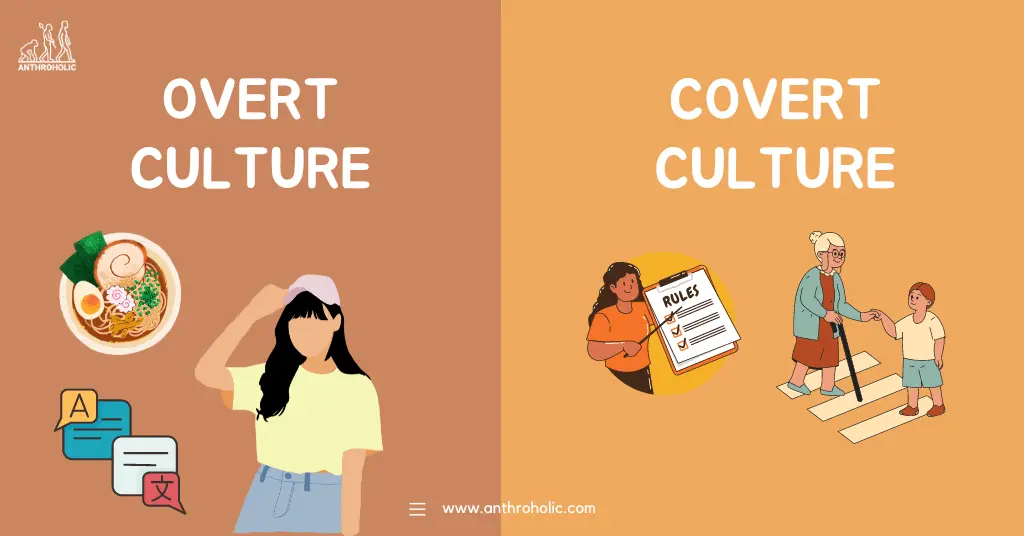AI Answer Evaluation Platform Live Now. Try Free Answer Evaluation Now
Overt and Covert Culture
The concept of culture can be understood as a complex interplay between overt and covert culture elements. For example, in an office environment, the overt culture might include dress code, visible work structures, and documented policies. However, the covert culture, often more influential, includes shared beliefs about work ethic, unspoken rules of interaction, and underlying assumptions about company values. Together, overt and covert culture shape the entire organizational culture, influencing how individuals behave, interact, and perceive their work environment.

The Tip of the Iceberg: Overt Culture
Overt culture is the visible or explicit part of a culture. It is the part of culture that outsiders can easily see, hear, and experience.
Examples of Overt Culture
- Language: The words we use and the languages we speak form a significant part of our overt culture.
- Dress and Fashion: Our clothing choices reflect cultural norms and can vary dramatically between cultures.
- Food: Each culture has a unique cuisine, characterized by different ingredients, preparation methods, and dining etiquette.
- Architecture: The design of buildings and structures often reflects cultural values, practices, and aesthetics.
- Music and Arts: These expressions of creativity are deeply embedded in cultural norms and traditions.
Beneath the Surface: Covert Culture
Covert culture is the hidden or implicit part of a culture that often goes unrecognized by its members unless they reflect on their actions or beliefs.
Examples of Covert Culture
- Values and Beliefs: Deep-seated beliefs and values guide our behavior and decisions, forming the crux of covert culture.
- Unspoken Rules and Etiquette: Every culture has unspoken norms regarding acceptable behavior, manners, and social interactions.
- Assumptions: Certain assumptions are so deeply embedded that we might not even be aware we’re making them.
- Taboos: These are forbidden actions or subjects which are typically avoided in a given culture.
- Worldview: The collective perception or understanding of the world, its workings, and our place within it, forms a significant part of the covert culture.
| Overt Culture | Covert Culture |
|---|---|
| Language | Values and Beliefs |
| Dress and Fashion | Unspoken Rules and Etiquette |
| Food | Assumptions |
| Architecture | Taboos |
| Music and Arts | Worldview |
The Dance of Overt and Covert Culture
The interplay between overt and covert culture is a fascinating dance, with one often influencing and being influenced by the other.
A. Overt Cultural Expressions Reflect Covert Values
- Dress Code and Decorum: The overt culture of dressing modestly in many societies may reflect the covert value of modesty or respect for certain societal norms.
- Architectural Designs: Monumental architectural works often reflect the deep-seated values and beliefs of a culture.
B. Covert Cultural Values Impact Overt Practices
- Cuisine and Dietary Habits: Certain food habits might originate from religious or spiritual beliefs. For example, dietary restrictions in certain religions reflect deep-seated spiritual values.
- Artistic Expression: The covert values of a society can profoundly impact its overt artistic expression. Art forms like music, dance, painting, or sculpture often convey underlying cultural messages or philosophies.
The Cultural Iceberg Model
The Cultural Iceberg Model, popularized by Edward T. Hall, provides a useful framework to visualize the relationship between overt and covert culture. Like an iceberg, only a small part of culture is visible (overt culture), while the majority remains unseen, beneath the surface (covert culture).
| Cultural Iceberg | |
|---|---|
| Visible (Overt Culture) | Language, Dress and Fashion, Food, Architecture, Music and Arts |
| Invisible (Covert Culture) | Values and Beliefs, Unspoken Rules and Etiquette, Assumptions, Taboos, Worldview |
Navigating Cultural Icebergs: Challenges and Strategies
While the distinction between overt and covert culture provides an insightful lens to perceive culture, navigating this cultural iceberg is a complex process. It involves recognizing and understanding the less tangible and often unspoken aspects of a society.
A. Challenges in Understanding Covert Culture
- Implicit Bias: Everyone carries their own set of biases, shaped by their cultural background. These biases can cloud our understanding of a new or different culture.
- Cultural Conditioning: We all are conditioned by our own cultures, making it difficult to recognize and question our assumptions.
- Language Barrier: Language, a significant part of overt culture, can often be a barrier to understanding the underlying covert cultural aspects.
B. Strategies to Navigate Cultural Icebergs
- Cultural Immersion: Immersing oneself in a new culture is a profound way to understand its overt and covert aspects. Living, working, or studying in a new cultural environment offers direct experience.
- Inter-cultural Dialogue: Open dialogues and exchanges with individuals from different cultures can provide insights into their covert culture.
- Education and Training: Academic courses, cultural sensitivity training, and language classes can help equip individuals with the necessary skills to understand and appreciate different cultures.
The Interplay of Overt and Covert Culture in Everyday Life
Everyday life is a theatre where overt and covert culture play their roles, often unnoticeably. Whether it’s the choice of greeting, the manner of serving and eating food, or the way we conduct business meetings, both overt and covert cultural aspects intertwine and influence our behaviors and choices.
A. Interactions and Communications
- Greetings: The act of greeting, an overt cultural aspect, often carries covert meanings and values. For instance, bowing in Japanese culture is not just a greeting but a reflection of respect and hierarchy.
- Conversational norms: The way we communicate, our choice of words, and our body language are shaped by the underlying covert culture.
B. Workplace Dynamics
- Workplace Etiquette: Office interactions, dress code, meeting decorum, and even office layouts are influenced by overt cultural norms, while underlying them are the covert values of hierarchy, respect, and personal space.
- Leadership Styles: Different cultures nurture different styles of leadership, often reflective of their covert values like power distance and individualism or collectivism.
Conclusion: Embracing the Depth of Culture
By understanding the interplay between overt and covert culture, we learn to see beyond the visible manifestations of culture. We delve deeper, beneath the surface of the iceberg, to appreciate the profound beliefs, values, and assumptions that shape societies. This comprehension not only fosters respect for diversity but also enables effective intercultural communication, a necessity in our increasingly interconnected world. Remember, just like an iceberg, the depth of a culture is much more than what meets the eye.



